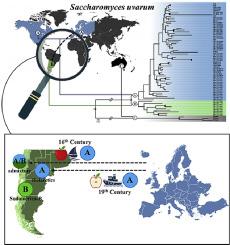Fungal Ecology ( IF 2.9 ) Pub Date : 2020-09-29 , DOI: 10.1016/j.funeco.2020.100990 Melisa Gonzalez Flores , María Eugenia Rodríguez , David Peris , Amparo Querol , Eladio Barrio , Christian Ariel Lopes

|
The domestication of Saccharomyces cerevisiae, as the result of its adaptation to human-manipulated processes, has been well analyzed by both phenotypic and genomic approaches. However, in other yeast species with industrial applications, such as Saccharomyces uvarum, these studies are very limited. To deepen knowledge about possible domestication in S. uvarum, an analysis of the genetic diversity of a series of S. uvarum strains isolated from different habitats was performed.
Our results show that the greatest S. uvarum population diversity worldwide is observed in Patagonia, where strains of this species can be isolated from industrial and traditional fermentations as well as from natural environments. This greater Patagonian diversity is due to the presence of strains belonging to two genetically differentiated populations, South America B (SA-B), and Holarctic/South America A (H/SA-A). The H/SA-A population of Patagonia is directly related to apple fermentation environments, mainly from cider fermentations but also, to a lesser extent, from traditional apple chicha. Our data suggest that strains from the Holarctic population colonized Patagonia. This is possibly associated with the introduction of apple trees by European immigrants, since the Spanish colonization of Chile in the 16th century and the introduction of new apple tree cultivars in the upper valley of the Negro River, Argentina, during the 19th century. During this process of colonization, Holarctic strains hybridized with SA-B yeasts, generating a series of admixed strains, mainly present in the traditional apple chicha fermentations.
中文翻译:

人相关的乌法 酵母菌向巴塔哥尼亚的迁移
酿酒酵母的驯化,由于其适应人类操纵的过程,已经通过表型和基因组方法进行了很好的分析。但是,在其他具有工业应用的酵母物种中,如葡萄糖酵母,这些研究非常有限。为了加深关于葡萄球菌可能驯化的知识,对从不同生境分离的一系列葡萄球菌菌株进行了遗传多样性分析。
我们的结果表明最大的葡萄球菌在巴塔哥尼亚观察到全世界人口的多样性,该物种的菌株可以从工业和传统发酵以及自然环境中分离出来。巴塔哥尼亚人的这种更大的多样性归因于属于两个遗传分化种群的菌株,即南美B(SA-B)和Holarctic /南美A(H / SA-A)。巴塔哥尼亚的H / SA-A种群与苹果发酵环境直接相关,主要与苹果酒发酵有关,而在较小程度上与传统的苹果奇查有关。我们的数据表明,来自Holarctic种群的菌株定居在巴塔哥尼亚。这可能是引进欧洲移民苹果树的关联,因为智利在16的西班牙殖民日世纪在内格罗河,阿根廷上游河谷引进新的苹果树品种中,有19人在日世纪。在定殖过程中,Holarctic菌株与SA-B酵母杂交,产生了一系列混合菌株,主要存在于传统的苹果chicha发酵中。



























 京公网安备 11010802027423号
京公网安备 11010802027423号